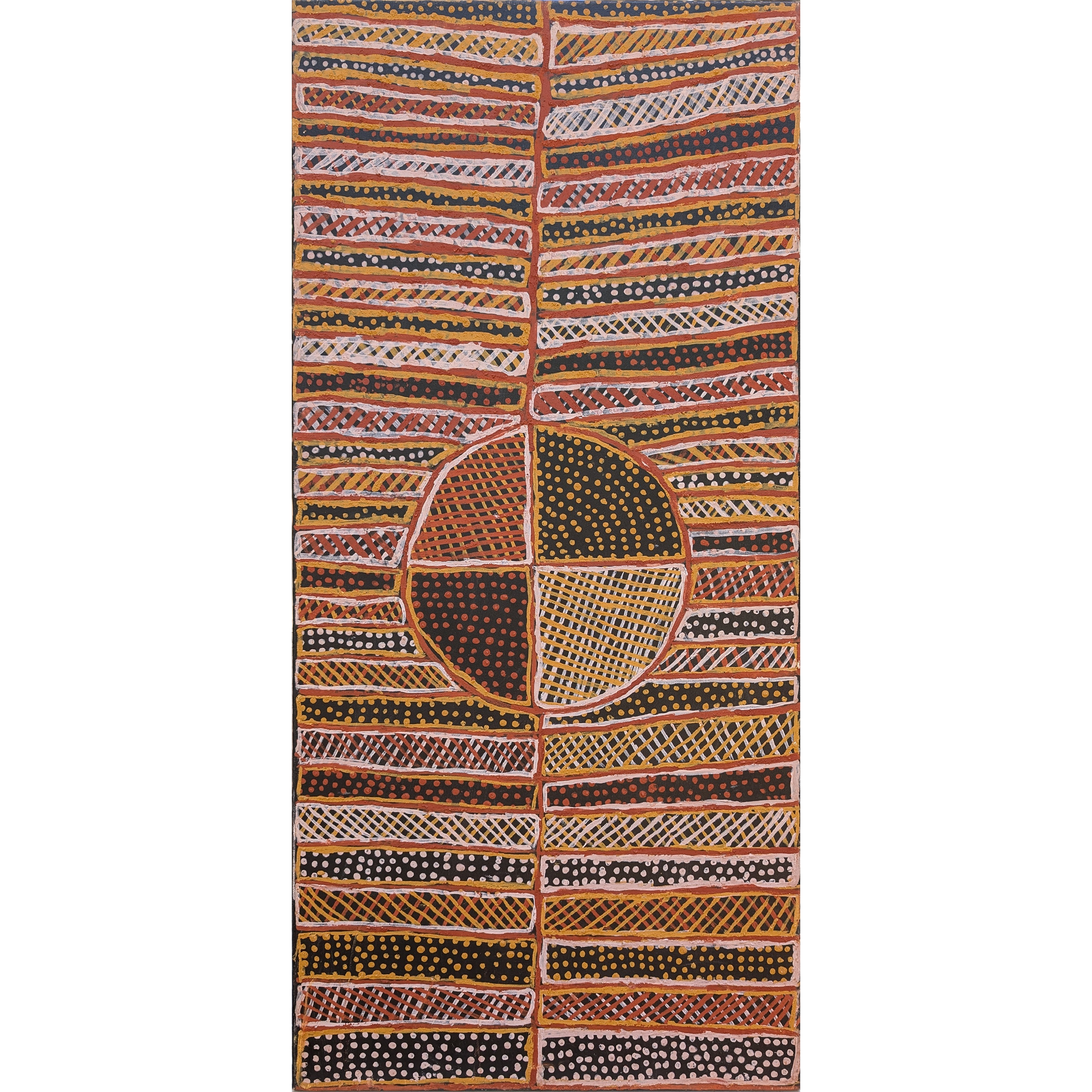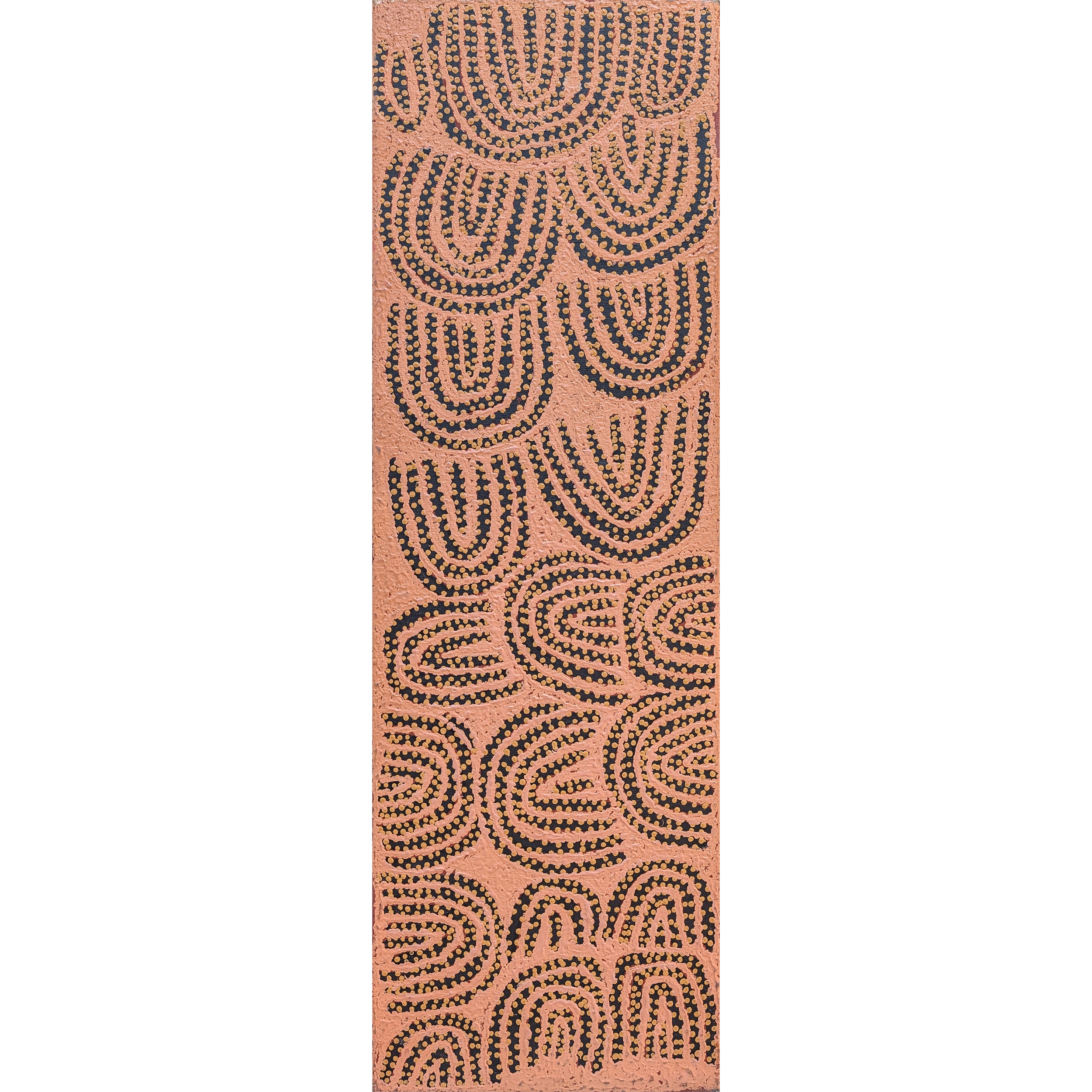
Artist: Jean Baptiste Apuatimi | Title: Kurlama/Pukamani poles | Year: 2001 | Medium: natural earth pigments on canvas | Dimensions: 115 x 54 cm
PROVENANCE
Tiwi Designs, NT Cat No. 162-01
Coo-ee Aboriginal Art Gallery, Sydney, NSW
Accompanied by a certificate of authenticity from Tiwi Designs
EXHIBITED
Big Country: Australian Aboriginal Art Coast to Coast, Jeffrey Moose Gallery Seattle USA, June - Sep. 2012
Black Art White Walls – The Anne and Adrian Newstead Collection:
- Grace Cossington Smith Gallery January – March 2014
- Wagga Wagga Art Gallery April-June 2014
- Moree Plains Gallery January -May 2015
- Burrinja Gallery, Upwey, Victoria July-Sept 2015
- Counihan Gallery, Moreland, Victoria, October – November 2015
- Caloundra Regional Gallery Jan – February 2016
O Tempo Dos Sonhos – The Time of Dreaming:
- CAIXAS Cultural in Brazil, São Paulo, Rio de Janeiro, Brasília, Recife and Fortaleza
- CASA FIAT DE CULTURA, Belo Horizonte, Brazil
- Museum of Art of Santa Catarina (MASC), Brazil
- Museum Cabanas, Guadalajara, Mexico
- Museo Nacional de las Culturas del Mundo, Mexico City, Mexico.
ARTWORK STORY
This painting incorporates both Pukamani poles and kulama. the Kulama is the central circle. Apuatimi says “that’s special Kulama yam we cook under the ground. Men rub it on their body to grow hair and keep healthy. That Kulama yam poison if you don’t cook it right.”
Pukamani poles are situated outside the circle. Apuatimi says “that poles name tutini, Pukamani Pole. For ceremony when people pass away. We put Pukamani Pole up for the last ceremony to help that spirit go to the next world. Family make Pukamani Pole for that final Pukamani ceremony."
Artist Profile
COMMUNITY/ REGION
Bathurst Island Tiwi, NT
LANGUAGE
Tiwi
BIOGRAPHY
Jean Baptiste Apuatimi, or Pulukatu as her father named her, was born at Pirlangimpi (Garden Point) on Melville Island in 1940. She was just 14 years of age and living at the convent in Nguiu (Wurrumiyanga) on Bathurst Island, when she married her late husband, Declan Apuatimi. Declan was a renowned dancer, singer and the pre-eminent Tiwi artist of his time. During their life together they raised fourteen children and, as she watched him create poles for important ceremonies, he taught her how to mix ochres and paint.
Her first works of art were included in group shows from 1991 onward, though it was not until 1997 that she became a full-time artist for the Tiwi Design Aboriginal Corporation. Over time she became an expert in various media, including printmaking.
Jean’s beautiful and personal paintings conform with the twin conventions of Tiwi art - moving between the figurative depiction of ceremonial objects, and body painting designs (Jilamara). Her Jilamara designs are of particular importance in her work and are both innovative and striking. Jilamara is unique to Tiwi art and culture. It typically consists of minga and pwanga, lines and dots, which sit within other geometric shapes such as squares and triangles. A number of these unique designs were passed on to Jean by her late husband, while others demonstrate her own individual genius and the power of Tiwi art as a regenerative creative force. Minga and pwanga can signify and express individual identities and skin groups on bodies, poles baskets and in paintings representative of ceremony.
Many of these decorative body designs date back to the time of the spirit ancestors. According to legend, they were created for the very first Pukamani (mortuary) ceremony, which was performed to mark the death of the primary Tiwi creator, Purukupali. Although ostensibly a mortuary ritual, the Pukumani is as much about rebirth and renewal, as it is about death. Amongst those that Jean Baptiste inherited from Declan, are jirtaka (sawfish) and parlini jilamara (body painting from the creation period). However, her own personal interpretation and adaptation of these have seen her move away from tight formal horizontal and vertical lines to a much freer, looser composition. Her finest works are characterised by the prominence of negative space, loose composition, and the magnification of design elements, as seen in her sawfish imagery. Jean is a meticulous painter who takes great care to keep her ochres pure. This ensures that they emanate the true power of this timeless Tiwi tradition.
In her later years, Jean Baptiste Apuatimi worked at Tiwi Design art centre, surrounded by younger artists who included her daughter Maria Josette Orsto and relatives Ita Tipungwuti, Margaret Renee Kerinauia and Roslyn Ortso. Sitting with Jean, these young women learned the importance of originality, and the expression of personality within their designs.
On first impression Jean appeared frail, even reserved. Yet this stood in stark contradiction to the power of her art, and the force with which she performed her Jarrangini (Buffalo) dance during ceremony. She had more than a dozen solo shows to her credit, and is represented in major private and public collections around the world. They include the Kluge-Ruhe Collection and National Museum of Women in the Arts in the United States of America. In 2007 she was selected to participate in the inaugural National Indigenous Art Triennial: Culture Warriors at the National Gallery of Australia, and in 2009, she exhibited to great acclaim at Rebecca Hossack Gallery, in London.
© Adrian Newstead
PROVENANCE
Tiwi Designs, NT Cat No. 162-01
Coo-ee Aboriginal Art Gallery, Sydney, NSW
Accompanied by a certificate of authenticity from Tiwi Designs
EXHIBITED
Big Country: Australian Aboriginal Art Coast to Coast, Jeffrey Moose Gallery Seattle USA, June - Sep. 2012
Black Art White Walls – The Anne and Adrian Newstead Collection:
- Grace Cossington Smith Gallery January – March 2014
- Wagga Wagga Art Gallery April-June 2014
- Moree Plains Gallery January -May 2015
- Burrinja Gallery, Upwey, Victoria July-Sept 2015
- Counihan Gallery, Moreland, Victoria, October – November 2015
- Caloundra Regional Gallery Jan – February 2016
O Tempo Dos Sonhos – The Time of Dreaming:
- CAIXAS Cultural in Brazil, São Paulo, Rio de Janeiro, Brasília, Recife and Fortaleza
- CASA FIAT DE CULTURA, Belo Horizonte, Brazil
- Museum of Art of Santa Catarina (MASC), Brazil
- Museum Cabanas, Guadalajara, Mexico
- Museo Nacional de las Culturas del Mundo, Mexico City, Mexico.
ARTWORK STORY
This painting incorporates both Pukamani poles and kulama. the Kulama is the central circle. Apuatimi says “that’s special Kulama yam we cook under the ground. Men rub it on their body to grow hair and keep healthy. That Kulama yam poison if you don’t cook it right.”
Pukamani poles are situated outside the circle. Apuatimi says “that poles name tutini, Pukamani Pole. For ceremony when people pass away. We put Pukamani Pole up for the last ceremony to help that spirit go to the next world. Family make Pukamani Pole for that final Pukamani ceremony."
Artist Profile
COMMUNITY/ REGION
Bathurst Island Tiwi, NT
LANGUAGE
Tiwi
BIOGRAPHY
Jean Baptiste Apuatimi, or Pulukatu as her father named her, was born at Pirlangimpi (Garden Point) on Melville Island in 1940. She was just 14 years of age and living at the convent in Nguiu (Wurrumiyanga) on Bathurst Island, when she married her late husband, Declan Apuatimi. Declan was a renowned dancer, singer and the pre-eminent Tiwi artist of his time. During their life together they raised fourteen children and, as she watched him create poles for important ceremonies, he taught her how to mix ochres and paint.
Her first works of art were included in group shows from 1991 onward, though it was not until 1997 that she became a full-time artist for the Tiwi Design Aboriginal Corporation. Over time she became an expert in various media, including printmaking.
Jean’s beautiful and personal paintings conform with the twin conventions of Tiwi art - moving between the figurative depiction of ceremonial objects, and body painting designs (Jilamara). Her Jilamara designs are of particular importance in her work and are both innovative and striking. Jilamara is unique to Tiwi art and culture. It typically consists of minga and pwanga, lines and dots, which sit within other geometric shapes such as squares and triangles. A number of these unique designs were passed on to Jean by her late husband, while others demonstrate her own individual genius and the power of Tiwi art as a regenerative creative force. Minga and pwanga can signify and express individual identities and skin groups on bodies, poles baskets and in paintings representative of ceremony.
Many of these decorative body designs date back to the time of the spirit ancestors. According to legend, they were created for the very first Pukamani (mortuary) ceremony, which was performed to mark the death of the primary Tiwi creator, Purukupali. Although ostensibly a mortuary ritual, the Pukumani is as much about rebirth and renewal, as it is about death. Amongst those that Jean Baptiste inherited from Declan, are jirtaka (sawfish) and parlini jilamara (body painting from the creation period). However, her own personal interpretation and adaptation of these have seen her move away from tight formal horizontal and vertical lines to a much freer, looser composition. Her finest works are characterised by the prominence of negative space, loose composition, and the magnification of design elements, as seen in her sawfish imagery. Jean is a meticulous painter who takes great care to keep her ochres pure. This ensures that they emanate the true power of this timeless Tiwi tradition.
In her later years, Jean Baptiste Apuatimi worked at Tiwi Design art centre, surrounded by younger artists who included her daughter Maria Josette Orsto and relatives Ita Tipungwuti, Margaret Renee Kerinauia and Roslyn Ortso. Sitting with Jean, these young women learned the importance of originality, and the expression of personality within their designs.
On first impression Jean appeared frail, even reserved. Yet this stood in stark contradiction to the power of her art, and the force with which she performed her Jarrangini (Buffalo) dance during ceremony. She had more than a dozen solo shows to her credit, and is represented in major private and public collections around the world. They include the Kluge-Ruhe Collection and National Museum of Women in the Arts in the United States of America. In 2007 she was selected to participate in the inaugural National Indigenous Art Triennial: Culture Warriors at the National Gallery of Australia, and in 2009, she exhibited to great acclaim at Rebecca Hossack Gallery, in London.
© Adrian Newstead






